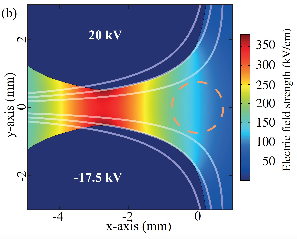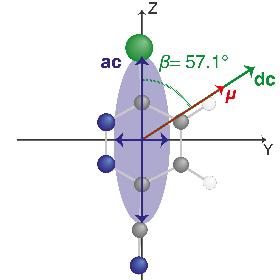New publications on improved control of cold complex molecules
30 June, 2017
Our publications entitled "Time-dependent analysis of the mixed-field orientation of molecules without rotational symmetry" and "Improved spatial separation of neutral molecules" have been accepted and published in the Journal of Chemical Physics.
Sketch of the structure of the 6-chloropyridazine-3-carbonitrile molecule. The electric dipole moment is not parallel to any principle axis of inertia.
In the first article entitled "Time-dependent analysis of the mixed-field orientation of molecules without rotational symmetry" we compute the time-dependent one-dimensional and three-dimensional orientation of a cold ensemble of 6-chloropyridazine-3-carbonitrile molecules in combined linearly or elliptically polarized laser fields and tilted dc electric fields. Our results for the one-dimensional orientation are in good agreement with recent experimental results for weak dc fields and we show that significant degrees of three-dimensional orientation can be achieved by applying strong dc fields or elliptically polarized laser pulses. In our work we analyze the non-adiabatic effects that characterize the mixed-field dynamics and highlight their impact on the mixed-orientation.
These results demonstrate our abilities to strongly control very complex molecules, to unravel the underlying quantum dynamics, and the possibilities to predict the alignment and orientation for future imaging experiments of molecules where experimental characterization of alignment and orientation is not straightforward – when calculations as presented here can serve as input for more elaborate computational analyses of experimentally recorded molecular movies.

Shape and electric fields of the new b-type deflector geometries. The numerically calculated electric field strengths for the actual electrode geometries are depicted in color coding. The dashed orange circle represent the undeflected molecular beam.
In the second publication, entitled "Improved spatial separation of neutral molecules" we experimentally demonstrated an improved electrostatic deflector for the spatial separation of molecules with a very open structure. It allows for significantly stronger electric fields as well as for stronger deflection without molecules crashing into the electrodes of the deflector, which allows for overall stronger deflection and, therefore, better separation of different molecular species. We have demonstrated its improved performance using the prototypical OCS molecule. In addition we discuss opportunities regarding improved quantum-state-selectivity for complex molecules and the deflection of unpolar molecules.
From these studies the improved performance is obvious and further work benefiting from this development is in progress.
Moreover, we have applied the deflector in a number of molecular imaging studies, including a recent beamtime at the LCLS x-ray free-electron laser facility at SLAC in California, USA; we are currently implementing an controlled-molecules injector for users of the European XFEL in the COMO enduser consortium..
